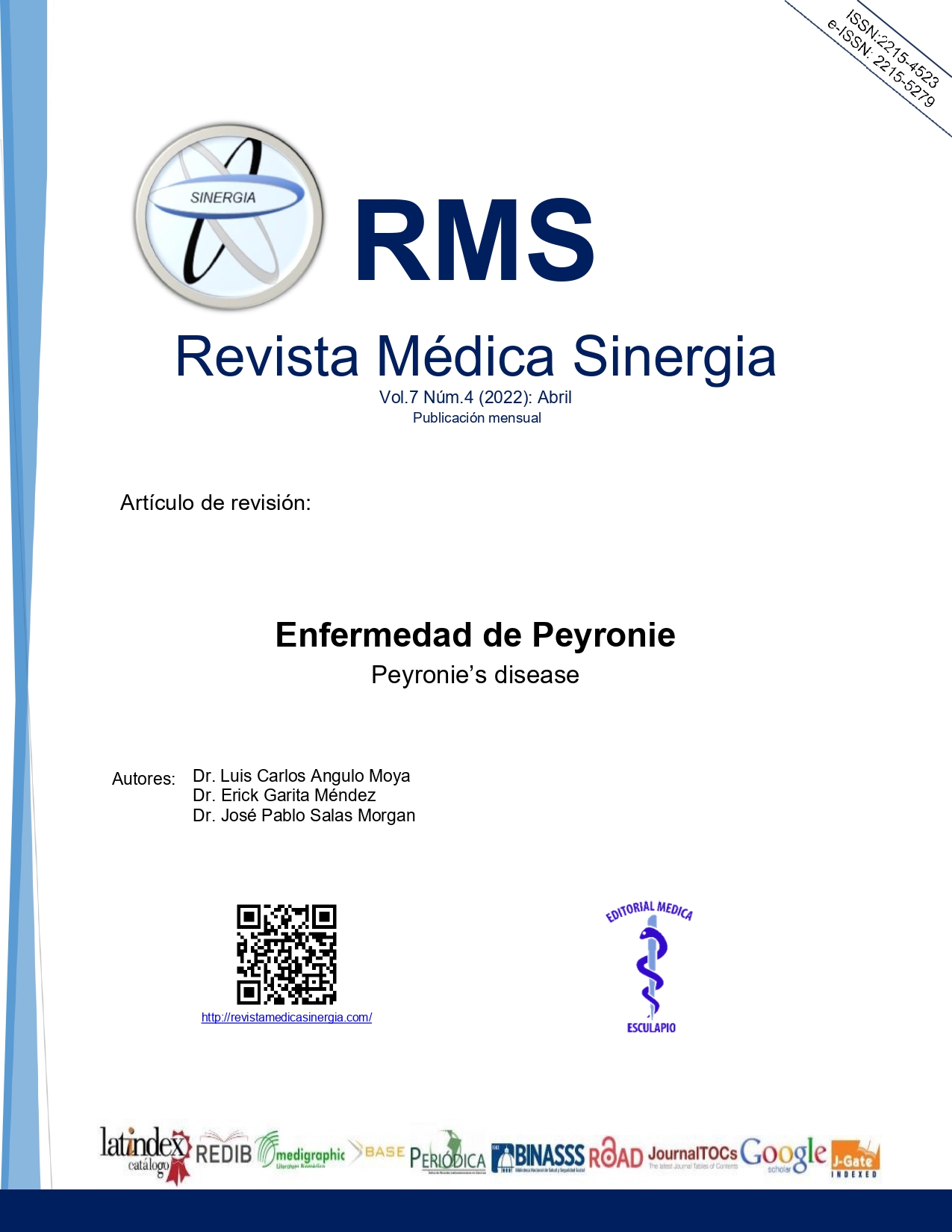Abstract
Peyronie's disease, also known as penile fibromatosis, is an acquired connective tissue disorder associated with the appearance of fibrotic nodules in the tunica albuginea of the penis, reducing its local elasticity and curving the penis during erection. Peyronie's disease increases in frequency with age, with its highest incidence during the fifth decade of life. Pathophysiologically, the exact cause of the formation of fibrotic plaques in the tunica albuginea is unknown, mainly associated with micro traumas during penetration. Additionally different hypotheses have been formulated as, for example, the dysfunction of matrix metalloproteinases, by which there would be a persistence of fibrotic tissue. Clinically there are two spectra of the disease, the acute phase and the stable phase, a patient with an acute picture will present with penile pain, changes in the penis during erection as curvatures or malformations, in a stable picture, the patient has no penile pain during erection and presents a penile curvature without further progression of the malformation. Both presentations are associated with psycho-social affectation of the patients, which is of extreme relevance and must be approached in an integral way with the treatment of the symptoms of the disease. During the clinical evaluation, therapeutic decisions will be made in relation to the extent of penile curvature and oral medical treatment with pentoxifylline or intralesional injections could be given. Additionally, there is the option of surgical treatment for certain cases of the disease.
Keywords
References
Teloken P, Katz D. Medical Management of Peyronie’s Disease: Review of the Clinical
Evidence. Medical Sciences. 2019;7(9):96.
Aita Giuliano, Ros Carlos Teodósio da, Silvinato Antonio, Bernardo Wanderley Marques. Peyronie’s disease: clinical treatment. Rev. Assoc. Med. Bras. [Internet]. 2019 Oct [cited 2020 Nov 30] ; 65( 10 ): 1231-1239. Available from: http://www.scielo.br/scielo.php?script=sci_arttext&pid=S0104- 42302019001001231&lng=en. Epub Nov 07, 2019.
Ferri FF. Peyronie Disease. In: Ferri's Clinical Advisor 2021 E-Book: 5 Books in 1. Elsevier Health Sciences; 2020. p. 1091.e2–1092.e5.
Brant WO, Bella AJ, Lue TF. [Internet]. Richie JP, Chen W, editors. Surgical management of Peyronie's disease. Wolters Kluwer; 2019 [cited 2020Jul26]. Available from: https://www.uptodate.com/contents/surgical-management-of- peyronies-disease/print
Lara-Becerra JA. EXPERIENCIA CON LA TÉCNICA QUIRÚRGICA HORTON- DEVINE EN PACIENTES CON ENFERMEDAD DE PEYRONIE: SERIE DE CASOS [thesis]. [Ciudad de Mexico]: IMSS; 2019. p. 1–36.
Ziegelmann MJ, Bajic P, Levine LA. Peyronie’s disease: Contemporary evaluation
and management. International Journal of Urology. 2020Jun;27(6):504–16.
Seftel AD, Yang H. Diagnosis and Management of Peyronie’s Disease. In: Campbell
Walsh Wein Urology. 12th ed. Elsevier Health; 2020. p. 1599–626.
Brant WO, Bella AJ, Lue TF. [Internet]. O'Leary MP, Givens J, editors. Peyronie's disease: Diagnosis and medical management. UpToDate; 2018 [cited 2020Jul26]. Available from: https://www.uptodate.com/contents/peyronies-disease-diagnosis-and- medical-management
Gabrielsen JS. Peyronie's disease: is it genetic or not?. Transl Androl Urol. 2020;9(Suppl 2):S262-S268. doi:10.21037/tau.2019.10.21
Babu A and Kayes O. Recent advances in managing Peyronie’s disease [version 1; peer review: 2 approved]. F1000Research 2020, 9(F1000 Faculty Rev):381 (https://doi.org/10.12688/f1000research.20557.1)
Allameh F, Razzaghi M, Rayegani SM, Fallah-Karkan M, Ranjbar A, Rahavian A, et al. Laser Therapy for Peyronie’s Disease: A Randomized Control Double-Blind Pilot Study. Journal of Lasers in Medical Sciences. 2019;10(5):37–42.
Serefoglu EC, Smith TM, Kaufman GJ, Yafi FA, Hellstrom WJG. Factors Associated With Erectile Dysfunction and the Peyronie's Disease Questionnaire in Patients With Peyronie Disease. Journal of Urology. 2017Sep;198(6):155–60.
Farrell MR, Ziegelmann MJ, Levine LA. Minimally invasive therapies for Peyronie's disease: the current state of the art. Transl Androl Urol. 2020;9(Suppl 2):S269-S283. doi:10.21037/tau.2019.08.06
DynaMed [Internet]. Ipswich (MA): EBSCO Information Services. 1995 - . Record No. T113775, Peyronie Disease; [updated 2018 Nov 30, cited place cited date here]. Available from https://www.dynamed.com/topics/dmp~AN~T113775. Registration and login required.
Tsambarlis P, Levine LA. Nonsurgical management of Peyronie's disease. Nat Rev Urol. 2019Mar;16(3):172–86.
Segundo A, Glina S. Prevalence, Risk Factors, and Erectile Dysfunction Associated With Peyronie’s Disease Among Men Seeking Urological Care. Sexual Medicine. 2020Jun;8(2):230–6.
Teron G, Gueglio G, Silva-Garretón A, Mayer M, Layús O, Rey-Valzacchi G. Utilización de pentoxifilina en fase aguda de enfermedad de La Peyronie. Revista Argentina de Urología. 2019;84(1):23–9.
Piamo-Morales AJ, García-Rojas MA. Uso de la elastosonografía en el diagnóstico de la enfermedad de Peyronie. Acta Médica del Centro. 2020;14(2):257–67.
Rachid M, Gallouo M, Graiouid M, Allali S, Seffar A, et al. (2020) Assessment of sexuality in patients with Peyronie’s disease. Int J Sex Reprod Health Care 3(1): 001- 004. DOI: 10.17352/ijsrhc.000008

This work is licensed under a Creative Commons Attribution-NonCommercial 4.0 International License.
Copyright (c) 2022 Array


